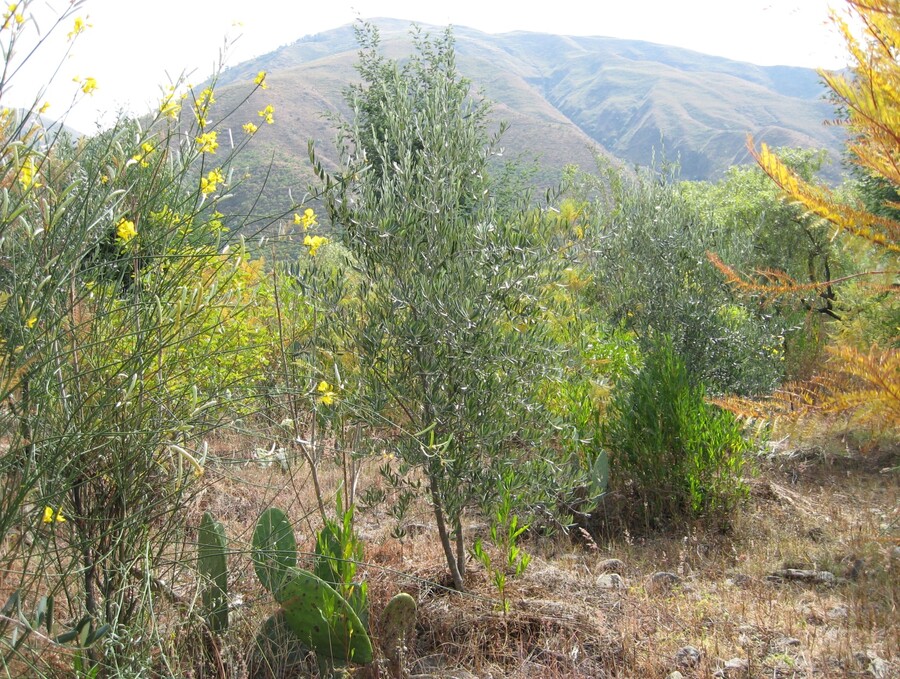From monoculture to diversity
The dynamic agroforestry method (Spanish: Agroforesteria dínamica, AD for short) is based on the insights gained by the indigenous people of Latin America and started being promoted and developed in the 90s by the German Development Service (DED).The positive results attained with AD led to the foundation of an agroforestry research centre in the uplands of Bolivia in 2001. This centre, Mollesnejta, is now our cooperation partner. The objective of the research is to find the optimal combination of plants for the location’s difficult conditions of being situated on hillsides at 2,800 metres’ height with degraded, rocky soil and a semiarid climate. Such a combination should involve simple and practical cultivation methods to attain a wide range of agricultural products.
Establishing and managing a plot
A dynamic agroforestry plot consists of various agricultural crops, fruit trees and a range of indigenous plants, above all native scrubs and trees, in order to imitate the closed nutrient cycles of a natural forest. The indigenous scrub and tree types take on various roles here. The plants with deep roots absorb water from the lower ground layers and carry it upward, thereby ensuring the ground remains moist. Regular pruning, particularly of the trees, makes sure the soil remains well-covered with a layer of foliage and mulch, which protects it from drying out. The clippings gradually decompose and the proportion of humus increases considerably. The increased level of humus and plant diversity lead to a natural balance between pests and useful organisms, which promotes the plants' overall wellbeing. Some plants take on a "nursing function" for the crops (such as maize, potatoes, vegetables, berries and fruit trees among others) by providing shade from wind, strong rain and hail, while simultaneously providing mulch and biomass. At the same time, they enrich the ground's fertility and moisture by adding humus and nitrogen nutrients.Periodic pruning is important
Maintaining a natural forest plot such as this consists above all of periodic pruning of the scrubs and trees, which keeps the system in a constant state of development. This considerably increases the cultivated crops' productivity. The layer of mulch, the thick layer of foliage and the deep root penetration counteract erosion, prevent eluviation of nutrients as well as the soil from drying out. This means that often neither fertiliser nor watering are required. The plot’s biodiversity mean pesticides are no longer needed, it promotes product diversification and thereby increases the crop yield.Benefits of dynamic agroforestry
A scientific study performed by the "San Pablo" Universidad Católica Boliviana on soil quality in Mollesnejta demonstrated that after just a few years using dynamic agroforestry on plots of land significantly increased the level of humus. A further agroforestry study carried out in 2013 on behalf of GIZ in the semiarid zones of the Cochabamba Departement showed that crops cultivated using dynamic agroforestry methods have a higher drought-tolerance, reduced problem of parasites and fewer plant diseases. It also means that less, sometimes barely any, watering, fertiliser or pesticides are needed. Although the workload is higher during the first three years compared to conventional production systems, in the medium and long-term, the workload and costs are lowered considerably. AGRECOL Andes, the SERNAP (Servicio Nacional de Áreas Protegidas) national park authority and the ECO-SAF agroforestry network wish to disseminate the agroforestry cultivation method within the Tunari National Park. AGRECOL Andes is familiar with the needs of smallholder families in the rural areas of Bolivia and solely participatory methods that actively include the target groups into all the project implementation processes are used. The principles of dynamic agroforestry are apparent. Converting arable land to a dynamic agroforest initially means more work for the smallholder families as well as adopting a new approach to cultivating crops. Training and consultation of the smallholders is therefore important during the entire duration of the project. Plant trees nowMore on the Andes cordilleraMore on the VicuñasBasic data: Tunari National Park
